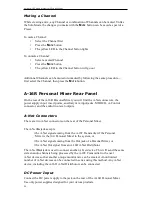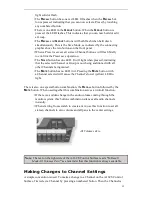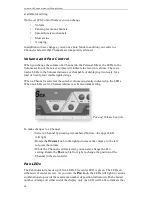
Aviom A-16 Personal Monitor Mixing System
22
23
A-16T Rear Panel
On the rear of the A-16T Transmitter you will find the power connector, the sixteen
audio inputs, and the sixteen Thru jacks.
Signal routing into and out of the A-16T Transmitter has been designed to be
extremely flexible, allowing the A-16T to integrate into virtually any audio environ-
ment.
Power Connector
Your A-16T Transmitter comes with a switching-type power supply. This type of
power supply can be used with a wide range of AC wall current outputs, meaning
that you do not need to replace the power supply if the unit will be used in different
countries throughout the world where current voltages are different. (You may,
however, need plug adapters to allow the power supply to be connected to wall
outlets internationally since many countries use different physical plug layouts for
their power systems.)
Channel Input Jacks
The rear panel of the A-16T Transmitter contains sixteen Input jacks (labelled
In).
These jacks can accept balanced or unbalanced signals on 1⁄4-inch plugs.
Balanced signals (sometimes referred to as
TRS
, for Tip, Ring, and Sleeve) are
found on many professional audio devices. The 1⁄4-inch connector used for balanced
audio wiring has three conductors: the tip, the ring, and the sleeve. It is the same
connector found on most stereo headphones, for example. The balanced wiring
system is ideal for keeping noise out of the audio signal from sources such as radio
interference (sometimes called “RF”).
Unbalanced audio signals are found on many keyboards, effects processors, etc.
Only two connectors are used, the tip and the sleeve. A standard musical instrument
or guitar cord uses this configuration, for example.
Channel Thru Jacks
The Thru jacks on the A-16T provide the user with an exact copy of the signal
plugged into the In jack just below it. This can be used as a way to insert the A-16T
















































